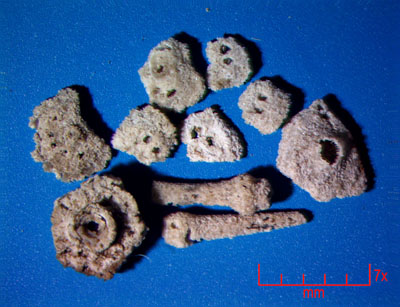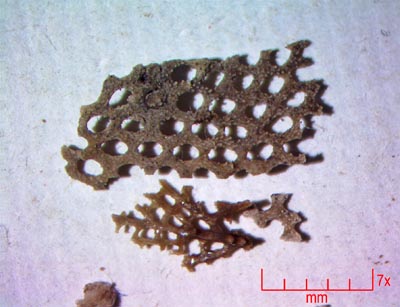|
Site 2 is
located about 250 feet down the trail from Site 1, and like Site
1, the fauna varied tremendously from one end to the other. The
first half of site 2 (Zone 1) is detailed here. The locality
is 50 paces long, and sparsely fossiliferous, we had a difficult
time gathering enough limestones to fill the gallon bag. Only
a small half teaspoon of decent microfossil from the increasing
amount of ground up shell hash was found. However some finds
had never been seen before!
NOTE: Click all
images to get the larger 1290 x 960 sized image.
Bryozoans

|
We
found two, possibly three types of bryozoans. On the left is
the ever present branching bryozoans found in great numbers at
this location. In the center is a section of fenestrate bryozoan,
one of only a few found. On the right is unusual, we have never
found this type before and is a very small piece. (Close up below) |

|
Branching
bryozoan, 30x. Numerous small pits pointing upward can be seen.
This allow an orientation to be preserved. |

|
Fenestrate
bryozoan close up at 30x. The individual zooecium are worn away
but can be still seen. |

|
This
is a close up of what appears to be something like a bryozoan,
but we are not sure yet until more specimens are found. |
Chonetids

|
Chonetids
are benthic tube worms that create spiral tests (shells) on the
sides of seaweed or other hard ground surfaces. They are very
gregarious and form clusters as seen in the central image here.
The top and bottom specimens were most likely cemented on seaweed
since they are flat on one side and not glued to a shell. |
Mollusks

|
The
mollusks are more evident than the previous site, but not as
well preserved. Many of them are ground up and found in small
pieces. These small specimens are all that we found intact in
the gallon bag of rock. Now here are a few close ups of individuals.. |

|
Astartella
subquandrata. The most common bivalve found. |

|
Parallelodon
anaklassium. The winged clams are stunning and rare. |

|
Genus
and species indeterminate. A classic shape for a bivalve, unfortunately
TOO common of a shape. |

|
Genus
and species indeterminate. One of these was found, in a very
rough condition. |

|
Palaeonucula
levatiformis. The smallest bivalves. Next to the head of a pin
for size comparison. |
Crinoids

|
Crinoids
are very rare in the Fort Apache at this site. Only one was found,
this two stack of ossicles. The hole was round in the center.
These of course are the stems of crinoids. |
Gastropods

|
Preservation
was not optimal, but a few good specimens were found. Here is
the entire lot of them we pulled out of the Gallon zip lock bag
of rock. It appears the more east we go along the outcrop, the
worse the preservation for gastropods. |

|
Goniasma
terebra. Deeply ribbed cones. |

|
Olive
shaped gastropods, species undetermined. |

|
Very
small spiral cones are amazing in detail and size. Very generic,
the genus and species are undetermined. |

|
The
stunning ornamentation on this species is diagnostic. This is
Paleostylus giganticus. |

|
Juvenile
squat cones. They are the smallest type found, and unidentified. |

|
Knighties
sp. which strongly resemble the much larger Bellerophontids.
Only one perfect specimen found here. |

|
I
call these "Honey Buns" and are almost always found
with the apertures side missing. They are Apachella prodontia. |

|
Apachella
prodontia. |

|
Larger
cones are common and are unidentified as they are very generic. |

|
A
worn specimen, possibly Goniasma terebra. |
Ostracods

|
Two
genus of ostracods are found commonly in the Fort Apache. One
type is a simple clam-shell type anatomy and the other are the
hollowed out halves of a more complex ear shaped ostracod. |

|
Close
up of the most common type. You can see the line where the two
halves open clearly here. Inside are small crustaceans which
the legs are protruded and are modified to collect plankton for
food. |
Scaphapods

|
Hordes
of scaphopods and thier juvinile teleoconchs were found. These
are mostly Plgioglypta canna, and the banded smaller ones are
thier juvinile teleoconchs. |
Straparollus
Gastropods

|
The
three phase growth of these large gastropods is noted here. They
start as a smooth round loose coil from the protoconch. Then
the spiral becomes square shaped. Finally, the tubercles along
the shell form. |

|
This
shows the round phase transitioning to the squared phase. The
protoconch is missing in the center. |
Trilobites

|
Only
a few fragments were found here. At top are the frontal rims
of the cranidium. To the right is an isolated rib. At bottom
- ? Possibly a glabella. |
Echinoids

|
Small
parts of urchins were found. Most of the spines were very eroded
looking, and the only parts to survive typically were the plates
with two holes that were the inlets for the water vascular system
seen here. |
Brachiopods

|
Productid
brachiopod spines were getting nearly full length here. We found
dozens of spines from thier shells, many of them still attached
to a small section of shell base. |
Sand,
minerals, crystals

|
There
were few good crystals found in the acid fines. Here, two quartz
crystals are seen and one mica crytal. |
|






































